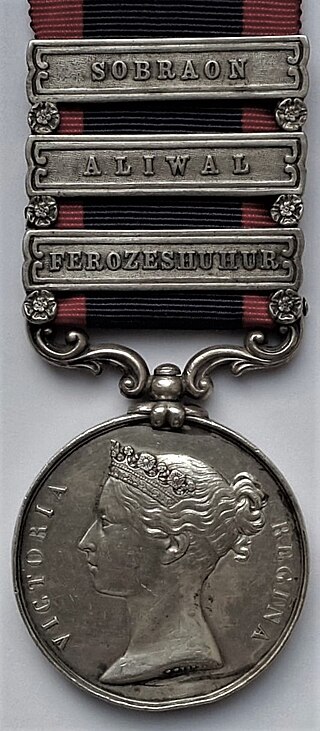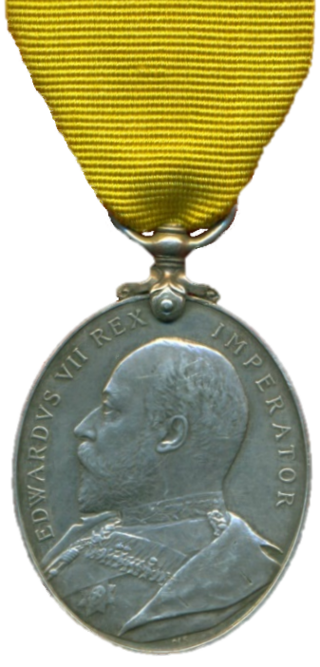
The Distinguished Service Medal (DSM) was a military decoration awarded until 1993 to personnel of the Royal Navy and members of the other services, and formerly to personnel of other Commonwealth countries, up to and including the rank of Chief Petty Officer, for bravery and resourcefulness on active service at sea.
To be mentioned in dispatches describes a member of the armed forces whose name appears in an official report written by a superior officer and sent to the high command, in which their gallant or meritorious action in the face of the enemy is described.

The 1914 Star, colloquially known as the Mons Star, is a British First World War campaign medal for service in France or Belgium between 5 August and 22 November 1914.

The Naval General Service Medal (NGSM) was a campaign medal approved in 1847, and issued to officers and men of the Royal Navy in 1849. The final date for submitting claims was 1 May 1851. Admiral Thomas Bladen Capel was one of the members of the board that authorised the medal.

The Military General Service Medal (MGSM) was a campaign medal approved in 1847 and issued to officers and men of the British Army in 1848.

The 1914–15 Star is a campaign medal of the British Empire which was awarded to officers and men of British and Imperial forces who served in any theatre of the First World War against the Central European Powers during 1914 and 1915. The medal was never awarded singly and recipients also received the British War Medal and Victory Medal.

The British War Medal is a campaign medal of the United Kingdom which was awarded to officers and men and women of British and Imperial forces for service in the First World War. Two versions of the medal were produced. About 6.5 million were struck in silver and 110,000 in bronze, the latter awarded to, among others, the Chinese, Maltese and Indian Labour Corps.

The Sutlej Medal was a campaign medal approved in 1846, for issue to officers and men of the British Army and Honourable East India Company who served in the Sutlej campaign of 1845–46. This medal was the first to use clasps to denote soldiers who fought in the major battles of the campaign.

The Victory Medal is a United Kingdom and British Empire First World War campaign medal.

The King George V Coronation Medal was a commemorative medal instituted in 1911 to celebrate the coronation of King George V, that took place on 22 June 1911.

The Australia Service Medal 1939–1945 recognises service in Australia's armed forces, Mercantile Marine and Volunteer Defence Corps during World War II.

The Rhodesia Medal was initiated by the British Government in consultation with Australia, New Zealand, Fiji and Kenya, whose forces took part in Operation AGILA. The role of the multi-national force was to keep peace between 22,000 guerrilla fighters and the Rhodesian forces during the ceasefire and run-up to the 1980 elections.

The Territorial Efficiency Medal (TEM) was a United Kingdom award for long service in the Territorial Army. It superseded the Territorial Force Efficiency Medal when the Territorial Force became the Territorial Army in 1921. It was superseded by the Efficiency Medal in 1930.

The Territorial Force Efficiency Medal was a United Kingdom award for long service in the Territorial Force between 1908 and 1921.

The Queen's Mediterranean Medal was authorised by King Edward VII and was awarded to Militia troops who had replaced their regular British Army counterparts in the various military garrisons across the Mediterranean, in Gibraltar, Malta and Egypt. This allowed regular troops to be available for the Second Boer War.

The Southern Rhodesia Service Medal 1939–1945 was a campaign medal of the British Commonwealth. It was awarded to members of the Southern Rhodesia Defence Forces for home service during World War II.

The Africa General Service Medal, established in 1902, was a campaign medal of the United Kingdom. It was awarded for minor campaigns that took place in tropical Africa between 1900 and 1956, with a total of forty five clasps issued. The medal is never seen without a clasp and some are very rare. Most medals were granted to British Colonial Auxiliary Forces units, including the King's African Rifles and the West African Frontier Force. The only campaigns where European personnel were present in any numbers were the various Somaliland campaigns,, and in Kenya.

The Ashanti Star was created in 1896 for the members of the expedition against the Ashanti King Prempeh, in the Fourth Anglo-Ashanti War that lasted from December 1895 to February 1896.

The Kabul to Kandahar Star, also known as the Roberts Star or Kandahar Bronze Star was awarded to those British and Indian troops who participated in the 320 mile march from Kabul to Kandahar in Afghanistan between 9–31 August 1880, under the command of Lieutenant-General Sir Frederick Roberts who rode horseback on his horse Vonolel In addition, it was awarded to the troops stationed en route at Kelat-i-Ghilzie, who accompanied General Roberts on the final ninety miles to Kandahar.

The Imperial Yeomanry Long Service Medal was a long service medal awarded by the United Kingdom. It is no longer awarded.



















